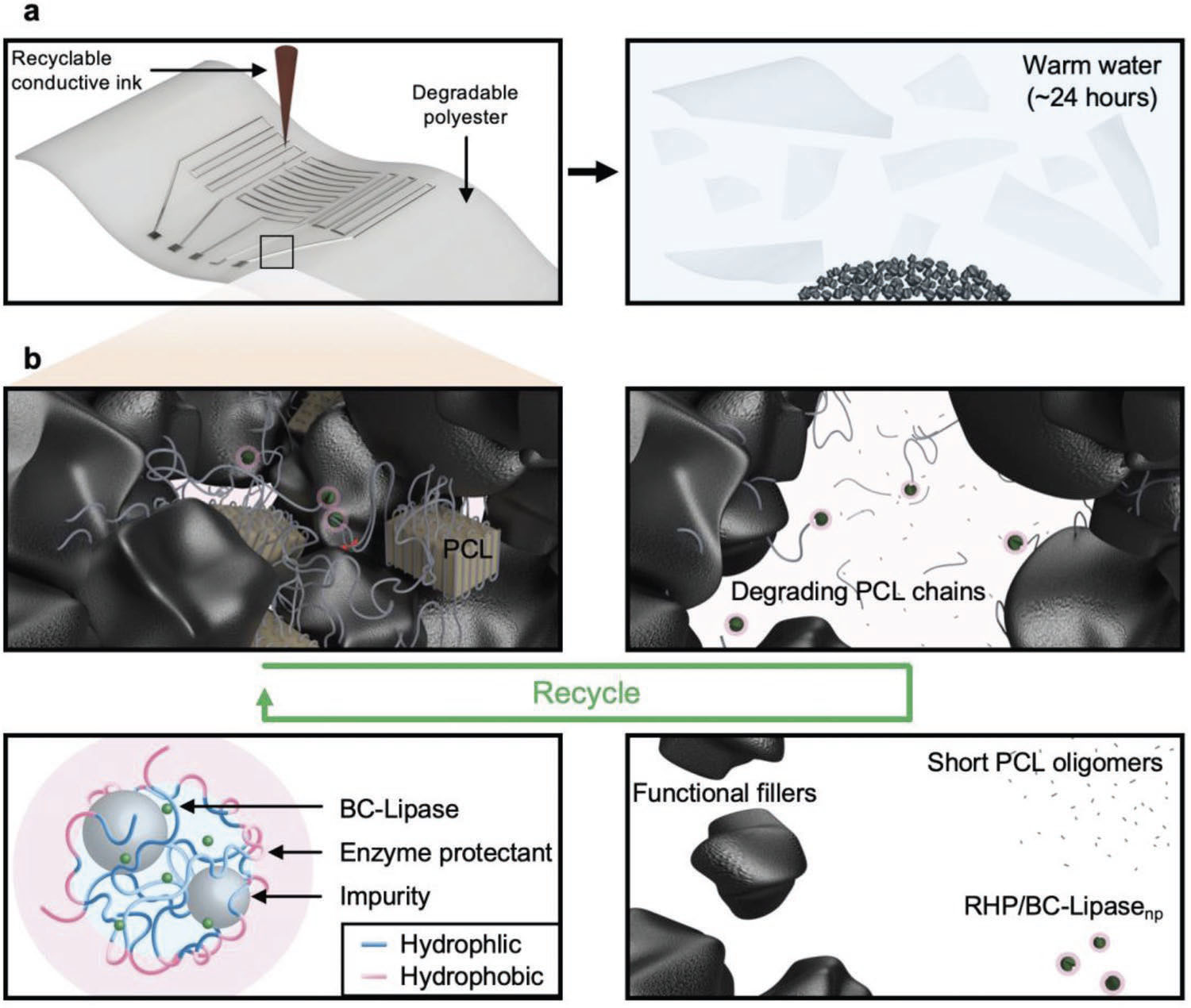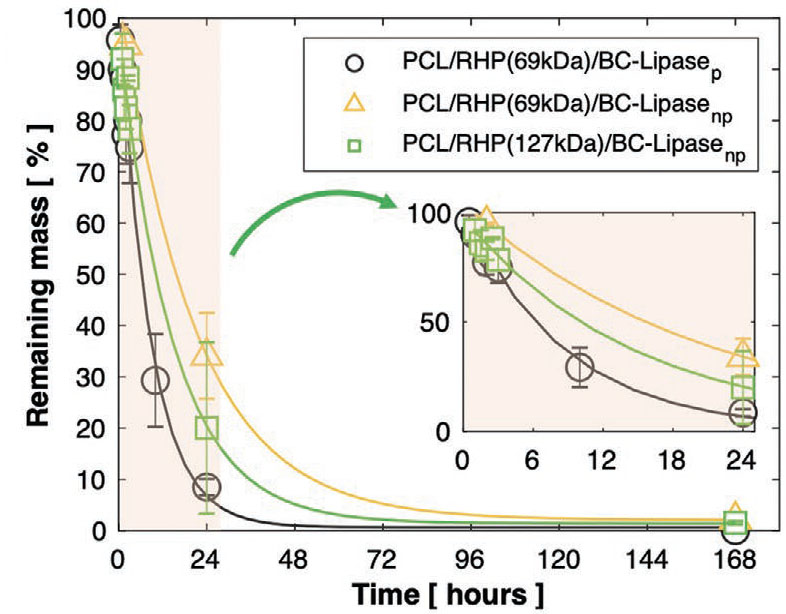| Jun 22, 2022 | |
Biodegradable electronic ink for recyclable printed electronics |
|
| (Nanowerk Spotlight) Electronics are integral to modern society, but electronic waste (e-waste) presents a complex and growing challenge in the path toward a circular economy – a more sustainable economic system that focuses on recycling materials and minimizing waste. More than 53 million metric tons of e-waste is generated each year – this is equivalent to throwing out 1000 laptops every single second. Only 20% of that e-waste is recycled. Most of the remaining 80% ends up in a landfill where it most likely will become an environmental problem. | |
| Until very recently, the recyclability of electronic devices hasn't played a role in their design, and existing recycling procedures lead to secondary pollution and insufficient recovery of precious components. Currently, e-waste recycling involves a lot of manual labor with mechanical crushers and (expensive) chemical baths to extract heavy metals, which can cause significant health and environmental problems. | |
| One solution could lie in 'physically transient electronics'. The goal of the electronics industry has always been to build durable devices with stable performance that last a very long time. Self-destructing, transient electronics however, are designed with the exact opposite goal: to dissolve harmlessly into their surroundings after functioning for a predetermined amount of time. These transient electronic devices work like regular electronics – until predetermined exposure to light, heat or liquid triggers their destruction. This stimuli-responsiveness is engineered into the protection layers of the electronic device. | |
| An environmental disaster even bigger than e-waste is plastic waste. Interfacing polymers with certain enzymes has shown to be a successful strategy for developing self-degradable plastic (see for instance: ("Near-complete depolymerization of polyesters with nano-dispersed enzymes" and "Synergistic Enzyme Mixtures to Realize Near-Complete Depolymerization in Biodegradable Polymer/Additive Blends") | |
| These studies in enzyme-containing plastics may also serve as the ideal entry point toward sustainable printed electronics and consequent e-waste reduction. Case in point is a recent report in Advanced Materials ("Conductive Ink with Circular Life Cycle for Printed Electronics") where researchers demonstrate novel biodegradable, recyclable, conductive, flexible, and printable materials that can be applied across many electronic devices to serve as a cornerstone for the development of ecofriendly and recyclable electronics. | |
| "We incorporated an enzyme cocktail (non-purified BC-Lipase) with random heteropolymers (RHP) into silver/polycaprolactone (Ag/PCL) composites to create degradable electronic inks" Junpyo Kwon, a PhD student in Prof. Ting Xu's research group at UC Berkeley, and the paper's first author, explains to Nanowerk. "The embedded enzymes catalyze the hydrolytic degradation of PCL chains in both films and printed states upon immersion in warm water. This RHP-assisted enzymatic depolymerization enables easy separation of electronic components and recycling of functional particles even after months of storage and use under ambient conditions." | |
| "Furthermore, temperature and post-heat treatment can be used to modulate the polymer degradation rates after direct ink writing," he adds. "As warm water is a main source to trigger the degradation and recycling, the proposed approach is more sustainable and potentially more cost effective than the use of toxic and expensive organic solvents in recycling of e-waste made of multi components." | |
 |
|
| The recycling mechanism of the printed circuits using RHP/BC-Lipasenp nanoclusters. a) Flexible electronic circuits fabricated by 3D printing or direct ink writing. The circuits can be disintegrated in warm water, and the separated fillers can be recollected. b) The conductive ink including functional fillers, PCL, and RHP/BC-Lipasenp. The PCL binder (represented by gray chains) degrades through enzyme-induced chain scission in warm water. RHP/BC-Lipasenp includes BC-Lipase (green), enzyme protectant (RHPs) highlighting the hydrophilic (blue) and the hydrophobic (pink) segments, and impurities (gray spheres). (Reprinted with permission by Wiley-VCH Verlag) | |
| By combining conductive silver fillers, biodegradable polymer binder, and enzymes, the researchers formulated a composite ink that is mechanically robust with a tensile strength of about 6.3 MPa, mechanical flexibility with ∼80% strain at break, and electrical conductivity of ∼2.1 ?? 104 S m???1. | |
| Electronic circuits printed with this ink on degradable polyester can be degraded simply by submerging them in warm water. The degradation rate and latency can be programed by thermal treatments. The silver fillers can be collected and reused with no observable loss in function. | |
| "The circuits remain fully functional and degradable after seven months of storage and one month of continuous operation under 3 V electrical voltage at room temperature without humidity control," Kwon points out. | |
| Crucial for practical applications, the enzyme-embedded composite ink can be prepared by using commercially available enzymes without resource-intensive purification processes. And the technology is cost-effective since the expensive metal fillers can easily be recycled after dissolution in a warm water bath at the circuits' end-of-life. | |
| The molecular weight (MW) of the RHPs affects the catalytic performance of the embedded enzymes and the team hypothesized that RHPs that have more pairs of favorable interactions with enzymes could compete with the interactions between the enzymes and commercial stabilizers. They tested RHPs with the same monomer composition but different MWs (69, 81, and 127 kDa) and found that, although the films prepared with purified BC-Lipase showed the highest degradation rates displaying 91.5% (±1.6%) weight loss over 24 hours, the 127 kDa RHP with the unpurified enzyme blend displayed comparable degradation performance. | |
 |
|
| Degradation profiles of PCL with purified BC-Lipase (PCL/RHP(69 kDa)/BC-Lipasep) and with nonpurified BC-Lipase (BC-Lipasenp) that was embedded with either 69 or 127 kDa RHP. (Reprinted with permission by Wiley-VCH Verlag) | |
| "We printed the degradable circuits using the composite dissolved in organic solvents (i.e., toluene) by direct-ink writing method," Kwon notes. "However, the use of organic solvents could also be problematic because of their toxicity and cost. Therefore, we also demonstrated hot-melt extrusion of the material at 60 °C. The melt-extruded filament also exhibited good electrical conductivity and degraded when immersed in warm water." | |
| The polycaprolactone used in this work is being actively used in many biomedical applications because of its degradability, biocompatibility, and mechanical strength. Therefore, the team reasons that their degradable conductive ink may also be applied in bioresorbable transient electronics for implantable devices and biosensors. | |
| In continuation of this work, the team is now trying to understand how proteins and polymers interact under diverse external conditions such as temperature and humidity. This will help them apply different materials and proteins and optimize manufacturing processes. | |
| "Our research is multi-disciplinary, from material synthesis to device fabrication, which requires many experts with fundamental knowledge and problem-solving skills," Kwon concludes. "Collaborating with good communications and applying new technologies, including machine learning or state-of-art 3D printing, seems challenging but crucial to continue the study." | |
 By
Michael
Berger
– Michael is author of three books by the Royal Society of Chemistry:
Nano-Society: Pushing the Boundaries of Technology,
Nanotechnology: The Future is Tiny, and
Nanoengineering: The Skills and Tools Making Technology Invisible
Copyright ©
Nanowerk LLC
By
Michael
Berger
– Michael is author of three books by the Royal Society of Chemistry:
Nano-Society: Pushing the Boundaries of Technology,
Nanotechnology: The Future is Tiny, and
Nanoengineering: The Skills and Tools Making Technology Invisible
Copyright ©
Nanowerk LLC
|
|
|
Become a Spotlight guest author! Join our large and growing group of guest contributors. Have you just published a scientific paper or have other exciting developments to share with the nanotechnology community? Here is how to publish on nanowerk.com. |
|
